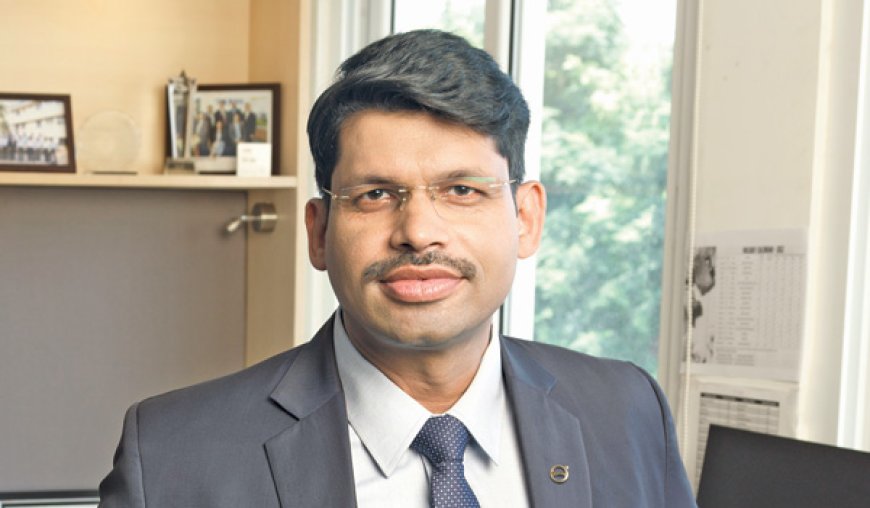The industry’s vision to secure the second position in global markets by 2030 seems within reach.
Dimitrov Krishnan, Managing Director, Volvo Construction Equipment What are the products that you have launched or displayed at Excon this year? Our recent launches have predominantly centered around electric innovations. This year, our overarching theme is change, and our primary

What are the products that you have launched or displayed at Excon this year?
Our recent launches have predominantly centered around electric innovations. This year, our overarching theme is change, and our primary objective in this showcase is to demonstrate the possibilities with electric-powered equipment to our valued customers.
Among our showcased innovations are two electric mini compactors and a pneumatic car roller, all conceived and engineered from scratch in India by our dedicated R&D team. These concept products, unveiled by Shri Nitin Gadkariji, signify our commitment to pioneering electric solutions.
A significant highlight is the EC80, an 8-ton electric excavator, marking our debut in this segment. We firmly believe that the shift to electric-powered machinery will gain traction rapidly, particularly within the mini excavator market, and the introduction of the 8-ton excavator reaffirms this belief.
Furthermore, we proudly present the Volvo EC500, a grid-connected excavator that eliminates the need for diesel engines or batteries. This solution, ideal for various sectors like cement, steel plants, and mining, operates by connecting directly to the grid.
Additionally, our battery electric loader, the L120, takes the spotlight, especially with the unveiling of the side dump loader variant tailored for tunneling applications. We foresee immense advantages for tunneling projects, given the zero-emission nature of electric loaders, negating the need for ventilation and ensuring optimal performance even in confined workspaces.
We’ve recently introduced a remarkable addition to our diesel range under the SDLG brand – the L956H, a groundbreaking 5-ton offering. This product is set to revolutionize the 5-tonne market with its strategic positioning and the compelling benefits it offers, complementing our existing L958 model.
In essence, these launches encompass our commitment to innovation, sustainability, and addressing industry-specific needs with cutting-edge electric solutions.
What are the technological features you have added in these machines?
The significant distinction lies in the power crane being entirely electric, omitting diesel engines in most models. This stands as a pivotal aspect. What’s truly impactful is our offering of these machines to customers as a service, eliminating the need for direct purchase. Clients can operate these machines on an hourly basis or opt to rent them for extended periods, alleviating concerns about the safety of their investment. We take charge of machine operation, not only mitigating investment risks but also ensuring safety. Upon deployment at the customer’s site, our team provides comprehensive training to operators, eliminating the challenge of unskilled personnel handling high-voltage machinery. This solution is instrumental in encouraging customer acceptance of electric machines in their applications, countering the considerable uncertainty otherwise associated with this transition, an area we are diligently addressing.
Which are the markets you are targeting with your launched products?
When it comes to compaction, our focus lies on products designed, developed, and manufactured right here in India. The versatility of these products allows us to explore diverse markets, not just in Asia but also in Europe and the US. Being battery electric machines, they bypass emission norms entirely, presenting a significant opportunity for us. These machines, initially introduced as concepts, are now ready to be deployed in customer applications. We’re not only showcasing the machines but also our comprehensive charging solutions. Our next step involves proving their efficiency, after which we aim to export these solutions worldwide.
How would you describe the current state of the construction equipment manufacturing industry?
The current fiscal year has displayed remarkable strength. Mr. Nitin Gadkari highlighted a staggering 26% year-over-year growth in his recent speech, marking it as a fantastic achievement. Projections indicate that in 2024, this industry might witness its largest-ever volume, estimated at roughly 125,000 units, corresponding to a substantial $10 billion from an industry size perspective. While global economies are slowing down, India’s equipment sectors continue to exhibit robustness across all categories.
The industry’s vision to secure the second position in global markets by 2030 seems within reach, given the current trajectory. Although the upcoming 2024 elections might have a slight impact, it’s anticipated to be minimal—perhaps a maximum of 10% to 15% influence on a market with a record high volume of 125,000 units. Consequently, the demand for 2024-25 remains reasonably strong.
As chairman of IESC, you have seen journey of IESC and the skilled operators in the industry and still, there is a shortage of skilled operators in India. What are the initiatives you are taking and what is our aim for the next two years?
Skilling remains an incredibly vital aspect in our industry. The establishment of the IESC around 8 or 9 years ago marked a significant commitment to training initiatives. Unfortunately, the onslaught of Covid-19 presented a major setback, disrupting our efforts. However, in the past two years post-pandemic, we’ve made strides towards recovery, and this year, we anticipate considerable progress in skilling endeavors.
It’s paramount to acknowledge the criticality of skilling, especially concerning the future landscape characterized by technological advancements. Notably, the infrastructure sector requires heightened productivity, a feat only achievable through skilled personnel adept at handling machinery directly. This necessity is pivotal.
Two fundamental requisites are imperative. Firstly, governmental intervention is crucial. Mandating certification for operator skills and permitting operation solely by certified individuals is vital. Presently, such a mandate is absent, but we’re actively collaborating with the government to address this gap.
Hits: 11








